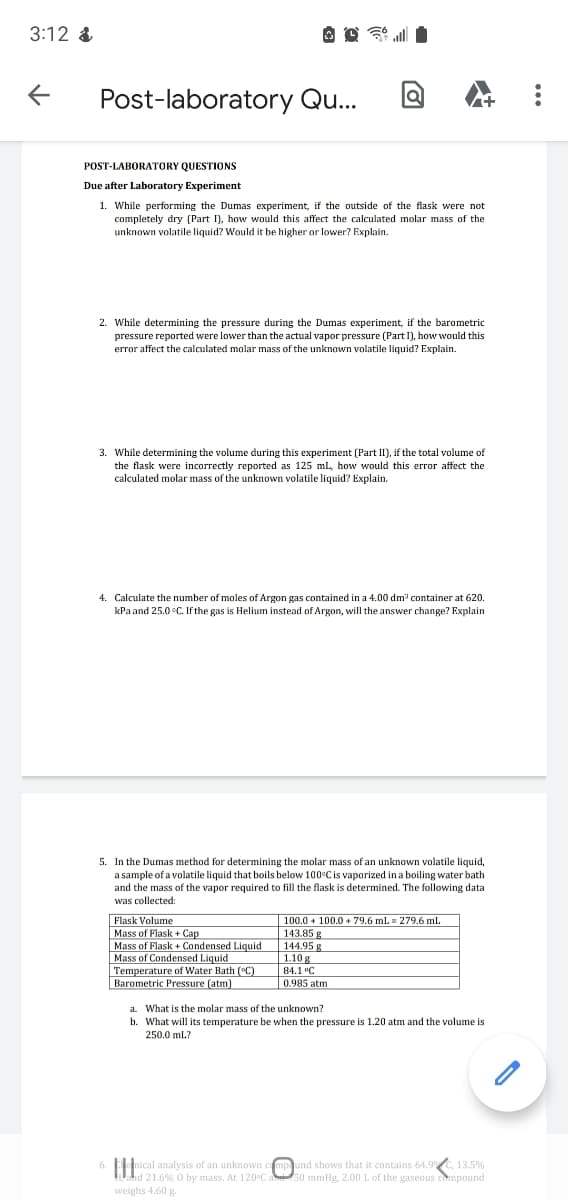1. While performing the Dumas experiment, if the outside of the flask were not completely dry (Part I), how would this affect the calculated molar mass of the unknown volatile liquid? Would it be higher or lower? Explain.
1. While performing the Dumas experiment, if the outside of the flask were not completely dry (Part I), how would this affect the calculated molar mass of the unknown volatile liquid? Would it be higher or lower? Explain.
Chemistry
10th Edition
ISBN:9781305957404
Author:Steven S. Zumdahl, Susan A. Zumdahl, Donald J. DeCoste
Publisher:Steven S. Zumdahl, Susan A. Zumdahl, Donald J. DeCoste
Chapter1: Chemical Foundations
Section: Chapter Questions
Problem 1RQ: Define and explain the differences between the following terms. a. law and theory b. theory and...
Related questions
Question

Transcribed Image Text:3:12 &
K
Post-laboratory Qu...
POST-LABORATORY QUESTIONS
Due after Laboratory Experiment
1. While performing the Dumas experiment, if the outside of the flask were not
completely dry (Part I), how would this affect the calculated molar mass of the
unknown volatile liquid? Would it be higher or lower? Explain.
2. While determining the pressure during the Dumas experiment, if the barometric
pressure reported were lower than the actual vapor pressure (Part 1), how would this
error affect the calculated molar mass of the unknown volatile liquid? Explain.
3. While determining the volume during this experiment (Part II), if the total volume of
the flask were incorrectly reported as 125 mL, how would this error affect the
calculated molar mass of the unknown volatile liquid? Explain.
4. Calculate the number of moles of Argon gas contained in a 4.00 dm³ container at 620.
kPa and 25.0°C. If the gas is Helium instead of Argon, will the answer change? Explain
5. In the Dumas method for determining the molar mass of an unknown volatile liquid,
a sample of a volatile liquid that boils below 100°C is vaporized in a boiling water bat
and the mass of the vapor required to fill the flask is determined. The following data
was collected:
6.
Flask Volume
Mass of Flask + Cap
Mass of Flask + Condensed Liquid
Mass of Condensed Liquid
Temperature of Water Bath (°C)
Barometric Pressure (atm).
100.0 100.0 +79.6 mL = 279.6 ml
143.85 g
144.95 g
1.10 g
84.1 °C
0.985 atm
a. What is the molar mass of the unknown?
b. What will its temperature be when the pressure is 1.20 atm and the volume is
250.0 mL?
HE
mical analysis of an unknown compound shows that it contains 64.9% C, 13.5%
and 21.6% 0 by mass. At 120°C a 50 mmHg, 2.00 L of the gaseous compound
weighs 4.60 g.
Expert Solution
This question has been solved!
Explore an expertly crafted, step-by-step solution for a thorough understanding of key concepts.
This is a popular solution!
Trending now
This is a popular solution!
Step by step
Solved in 2 steps

Knowledge Booster
Learn more about
Need a deep-dive on the concept behind this application? Look no further. Learn more about this topic, chemistry and related others by exploring similar questions and additional content below.Recommended textbooks for you

Chemistry
Chemistry
ISBN:
9781305957404
Author:
Steven S. Zumdahl, Susan A. Zumdahl, Donald J. DeCoste
Publisher:
Cengage Learning

Chemistry
Chemistry
ISBN:
9781259911156
Author:
Raymond Chang Dr., Jason Overby Professor
Publisher:
McGraw-Hill Education

Principles of Instrumental Analysis
Chemistry
ISBN:
9781305577213
Author:
Douglas A. Skoog, F. James Holler, Stanley R. Crouch
Publisher:
Cengage Learning

Chemistry
Chemistry
ISBN:
9781305957404
Author:
Steven S. Zumdahl, Susan A. Zumdahl, Donald J. DeCoste
Publisher:
Cengage Learning

Chemistry
Chemistry
ISBN:
9781259911156
Author:
Raymond Chang Dr., Jason Overby Professor
Publisher:
McGraw-Hill Education

Principles of Instrumental Analysis
Chemistry
ISBN:
9781305577213
Author:
Douglas A. Skoog, F. James Holler, Stanley R. Crouch
Publisher:
Cengage Learning

Organic Chemistry
Chemistry
ISBN:
9780078021558
Author:
Janice Gorzynski Smith Dr.
Publisher:
McGraw-Hill Education

Chemistry: Principles and Reactions
Chemistry
ISBN:
9781305079373
Author:
William L. Masterton, Cecile N. Hurley
Publisher:
Cengage Learning

Elementary Principles of Chemical Processes, Bind…
Chemistry
ISBN:
9781118431221
Author:
Richard M. Felder, Ronald W. Rousseau, Lisa G. Bullard
Publisher:
WILEY